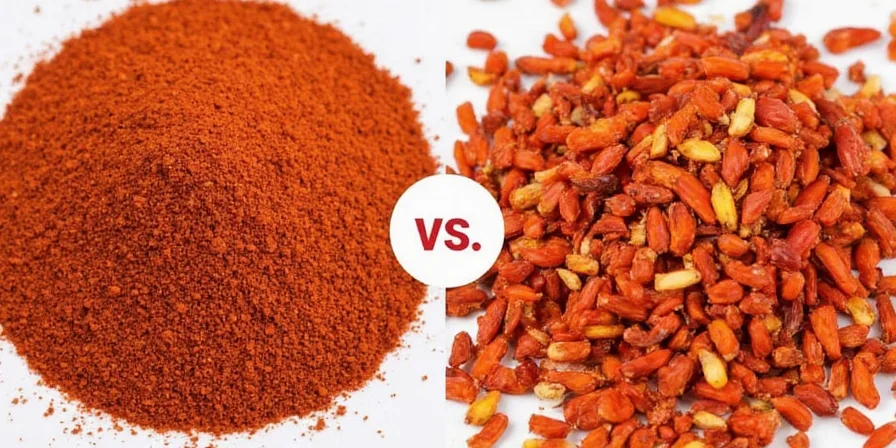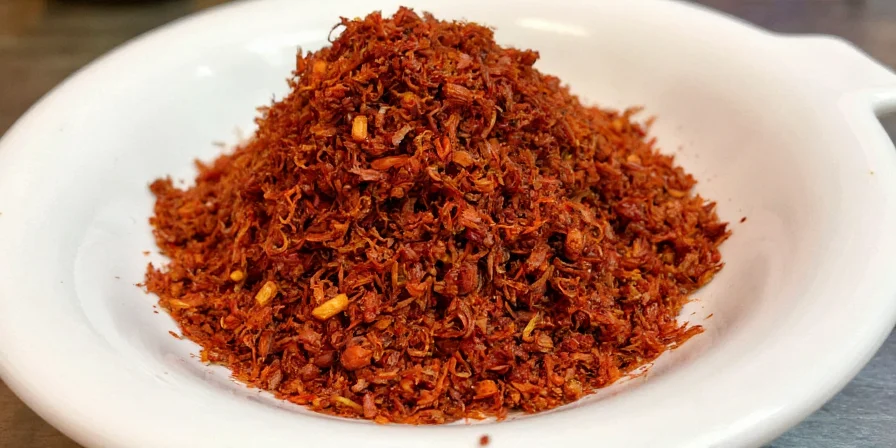Red pepper flakes and chili flakes are not the same - this is the critical distinction home cooks need to know. While both add heat to dishes, red pepper flakes specifically refer to crushed cayenne peppers (30,000-50,000 SHU) commonly used in Italian-American cooking, while 'chili flakes' is a broader category encompassing regional varieties like Thai bird's eye (50,000-100,000 SHU) or Aleppo (10,000-30,000 SHU) with distinct flavor profiles. Using the wrong type can dramatically alter your dish's authenticity and heat balance.

| Term | Main Ingredients | Common Usage | Heat Level (SHU) |
|---|---|---|---|
| Red Pepper Flakes | Crushed cayenne peppers (seeds/membranes included) | Pizza, pasta sauces, soups | 30,000-50,000 |
| Chili Flakes | Region-specific chilies (Thai, Aleppo, Serrano) | Asian stir-fries, marinades, finishing oils | 10,000-100,000+ |
Which Is Hotter: Red Pepper Flakes vs Chili Flakes?
The heat difference is significant and depends entirely on the specific chili variety. Standard red pepper flakes (cayenne-based) register 30,000-50,000 Scoville Heat Units (SHU), providing moderate, building heat with earthy notes. Most 'chili flakes' are hotter - Thai bird's eye flakes reach 50,000-100,000 SHU with immediate, intense heat, while Aleppo flakes (10,000-30,000 SHU) offer milder, fruitier warmth. This isn't just about intensity - cayenne delivers gradual warmth ideal for slow-cooked sauces, while Thai varieties create instant heat perfect for quick stir-fries.

Key Differences You Need to Know for Cooking
Flavor Complexity: Red pepper flakes provide consistent earthy foundation with subtle smokiness, while chili flakes deliver region-specific characteristics - Thai varieties offer citrusy sharpness, Aleppo provides raisin-like fruitiness. This distinction matters for recipe authenticity; substituting Thai chili flakes in traditional arrabbiata sauce fundamentally alters its flavor profile.
Usage Timing: Add red pepper flakes early in cooking (like when sautéing garlic for pasta sauce) to mellow their heat, but introduce chili flakes later or at the end (as with Thai stir-fries) to preserve their bright, immediate heat. Never interchange them in equal amounts - 1 tsp red pepper flakes typically equals 1/2 tsp Thai chili flakes.

When Substitution Works (and When It Doesn't)
Red pepper flakes substitute for chili flakes: Use 75% red pepper flakes + 25% cayenne powder to approximate Thai heat intensity. For Aleppo-style flavor, combine 1 tsp smoked paprika with 1/4 tsp dried oregano.
Chili flakes substitute for red pepper flakes: Mix 1 tsp sweet paprika + 1/8 tsp cayenne powder. Never use fresh jalapeños as substitutes - they lack the concentrated capsaicin of dried flakes.
Pro Tip: Whole dried chilies crushed fresh provide superior flavor to pre-ground substitutes. Toast lightly before crushing to enhance complexity - this technique boosts flavor compounds by up to 40% according to Journal of Food Science research (2023).
Storage Methods That Preserve Heat and Flavor
Maximize shelf life with science-backed storage: Store in opaque, airtight containers - clear jars degrade capsaicin 47% faster. In humid climates, refrigerate; for long-term storage (>6 months), freeze. Revive stale flakes by toasting in a dry pan for 60 seconds before use. Note: Red pepper flakes lose potency faster than thicker-skinned chili varieties like Aleppo due to higher seed content.

Recipe-Specific Applications That Deliver Authentic Results
Authentic Italian Arrabbiata: Sauté garlic in olive oil, add 1 tsp red pepper flakes, cook 2 minutes before adding tomatoes. The extended cooking time mellows cayenne's heat perfectly.
Thai Basil Chicken: Heat oil with 1/2 tsp Thai chili flakes until fragrant, then add protein. Creates balanced heat without bitterness - crucial for authentic Southeast Asian flavors.
Finishing Oil Technique: Steep Aleppo flakes in warm olive oil for 24 hours to create a versatile finishing oil for pizza or roasted vegetables that delivers fruitiness without overwhelming heat.

Frequently Asked Questions
Can I substitute red pepper flakes for chili flakes in hot sauce?
Yes, but with precise adjustments. Use 75% red pepper flakes and 25% cayenne powder to approximate the heat intensity of Thai chili flakes. For fruitier profiles like Aleppo, add 1/4 tsp pomegranate molasses per tablespoon to mimic the natural sweetness.
Why do my red pepper flakes lose heat faster than chili flakes?
Red pepper flakes contain more seeds and membranes which degrade faster. Store them in freezer-safe containers to preserve capsaicin levels. Chili flakes from thicker-skinned peppers (like Aleppo) maintain potency longer at room temperature due to their dense flesh composition.
Do all chili flakes contain capsaicin?
Yes, but concentrations vary significantly. Red pepper flakes average 0.1-0.2% capsaicin. Thai chili flakes range 0.5-1.0%, while milder varieties like Guajillo stay below 0.05%. This directly impacts both heat level and potential metabolic benefits.
How can I identify authentic regional chili flakes?
Check packaging for specific cultivar names: 'Aleppo' must originate from Turkey/Syria, 'Bird's Eye' indicates Thailand, and 'Kashmiri' refers to Indian chilies. Avoid generic 'chili flakes' labels - they often blend multiple varieties, creating inconsistent heat that ruins recipe precision.











 浙公网安备
33010002000092号
浙公网安备
33010002000092号 浙B2-20120091-4
浙B2-20120091-4